Wildlife In Roatan, Honduras
Which Species of Grouper Can You Find In Roatan?
Did you know that there are approximately 150 different kinds of groupers in the world? Of those 150, 37 species have been found spawning in the Caribbean – including the Bay Islands!
Roatan Groupers: General Facts
Groupers are opportunistic predators, consuming a diverse array of prey including fish, crustaceans, octopus, and squid. Utilizing their large mouths and powerful gill muscles, they employ a suction feeding method to capture their food, with some species employing ambush tactics while others actively hunt their prey.
Remarkably, groupers are mostly monandric protogynous hermaphrodites, meaning they are born and mature as females before transitioning to males for reproduction. While some species, like the Black Grouper, are relatively easy to spot, others, such as the elusive Goliath Grouper, may require more effort to locate in the wild.
With a potential lifespan of up to 50 years or more, groupers are among the long-lived inhabitants of the ocean, adding to the allure and intrigue of encountering these majestic creatures during diving expeditions in the Bay Islands.
Species of Grouper Found On Roatan
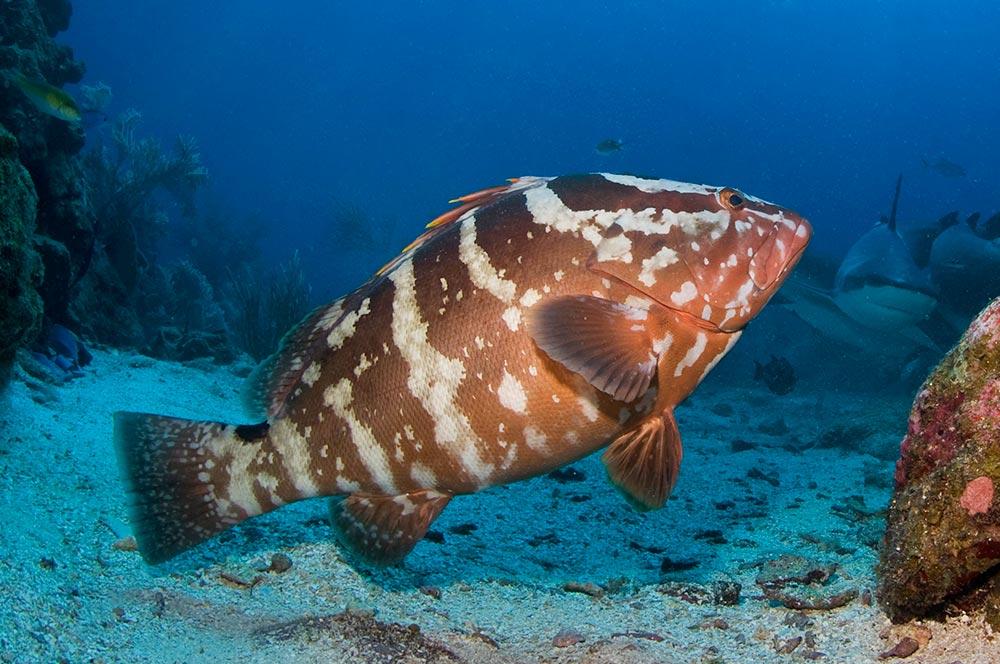
Nassau Grouper
(Epinephelus striatus)
The Nassau Grouper is easily recognizable by its distinct coloration, which shifts from tawny in shallow waters to pinkish or orange-red in deeper areas. Despite its striking appearance, it faces threats from overfishing and habitat loss, earning a threatened status under the Endangered Species Act. These groupers can live up to 29 years, typically inhabiting offshore reefs and drop-offs, while juveniles seek shelter in nearshore reefs.
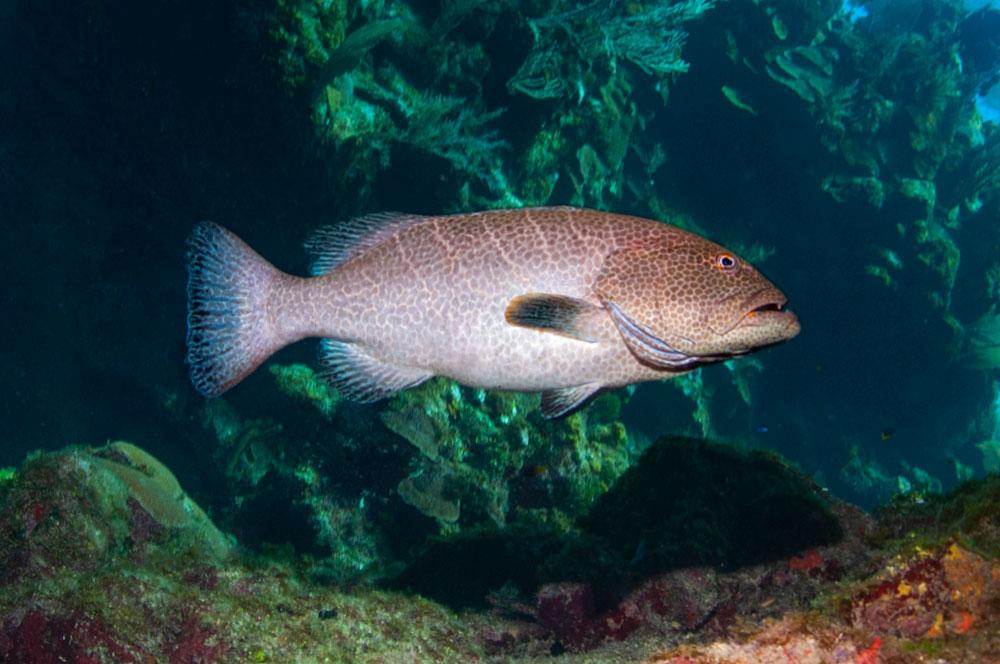
Tiger Grouper
(Mycteroperca tigris)
The Tiger Grouper is a solitary hunter with a robust, striped body, often reddish with darker lines, while juveniles display vibrant yellow hues. It thrives in coral reefs and rocky habitats, living up to 30 years. Known for its ambush tactics, it hides among corals and sponges to prey on fish. This species can also change color, shifting from pale to dark red, especially at cleaning stations.

Black Grouper
(Mycteroperca bonaci)
Black Groupers, among the Caribbean’s most common grouper species, feature olive, grey, or brown bodies with irregular black blotches. Solitary by nature, they spawn between May and August and can live up to 40 years. Adults prey on fish and squid, while juveniles feed mainly on crustaceans. Found in deep offshore waters near rocky bottoms and drop-offs, adults favor wrecks, while juveniles seek shelter in shallower coastal areas.
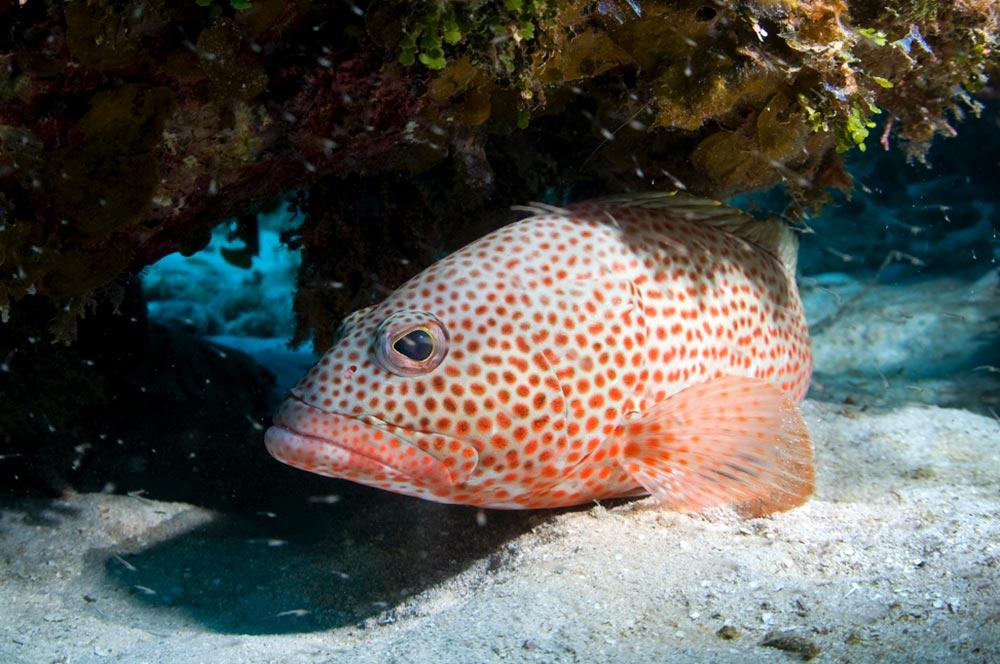
Red Hind
(Epinephelus guttatus)
The Red Hind, or Speckled Hind, has a robust white body covered in red spots, with a black-edged tail bordered in white. Unlike the Rock Hind, it lacks spots on its tail or dorsal fin. Prized for its taste, it faces overfishing in many areas. With a lifespan of about 17 years, this solitary fish inhabits shallow reefs and rocky seabeds, fiercely defending its territory.

Rock Hind
(Epinephelus adscensionis)
The Rock Hind, similar to the Red Hind, has a sturdy, tan body speckled with reddish spots but lacks a black-edged tail. Both species share the unique ability to swivel their eyes in their sockets. Less elusive than its cousin, the Rock Hind is often found on rocky reefs, where it hunts crabs and fish. Typically solitary, it plays a vital role in the marine ecosystem and can live up to 30 years.
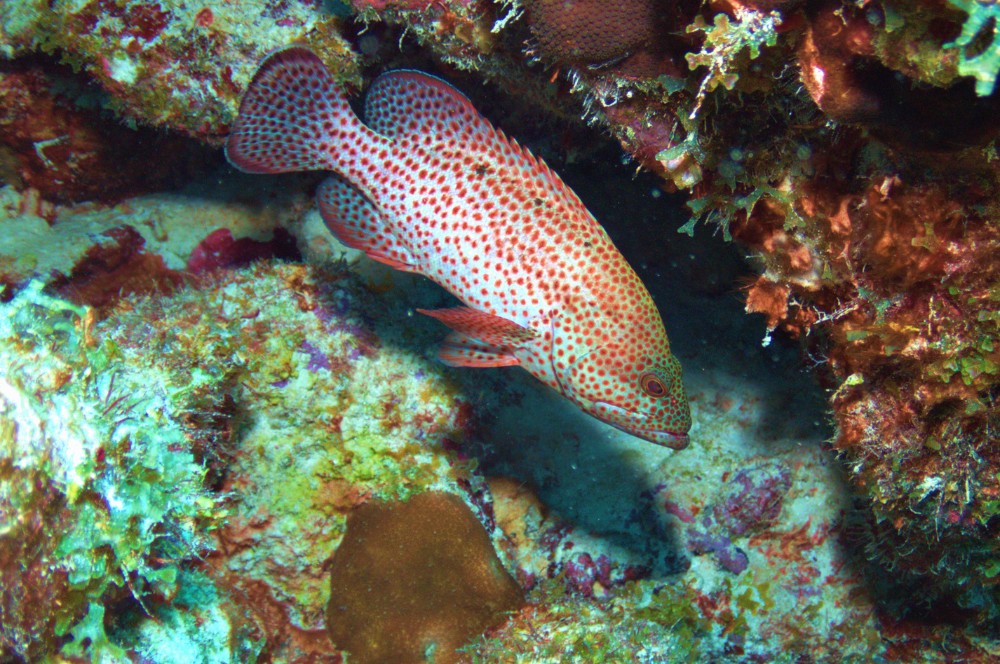
Graysby
(Cephalopholis cruentata)
The Graysby is the smallest grouper species in the Bay Islands, characterized by its compact, robust body with reddish-brown or gray hues and dark orange spots, often featuring three to five dark spots along its dorsal fin. A nocturnal predator, adults feed on small fish, while juveniles prefer shrimp. Solitary and secretive, they inhabit seagrass beds and quickly seek shelter throughout their short lifespan of 13 years.
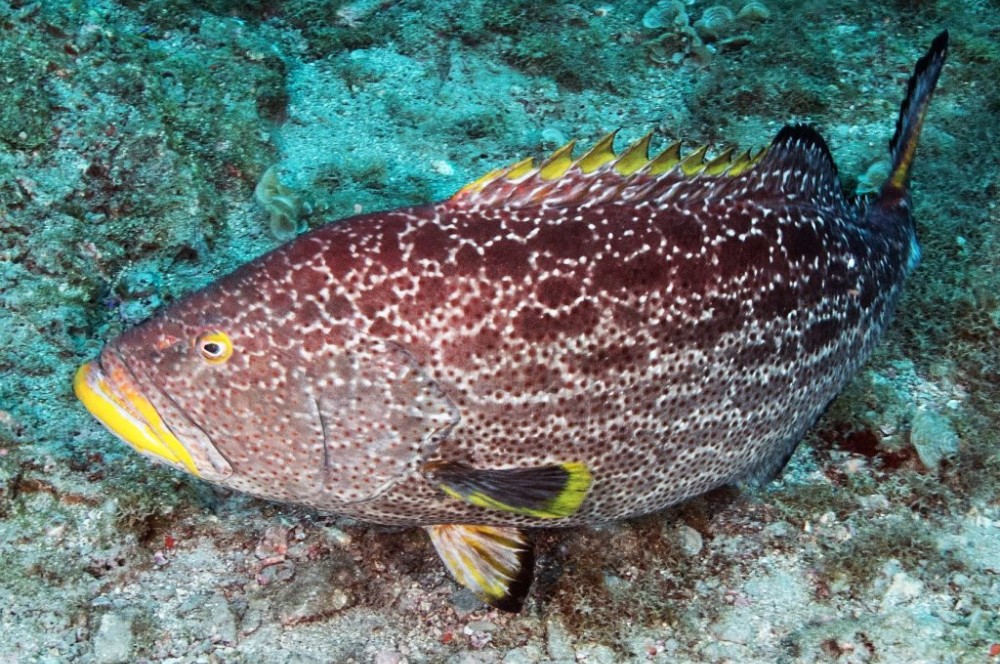
Yellowfin Grouper
(Mycteroperca venenosa)
The Yellowfin Grouper features two distinct color variations: greenish-gray in shallow waters and vibrant red in deeper areas, both marked with dark oval spots. Named for its bright yellow pectoral fins, this species primarily preys on reef fish and squid. While adults favor rocky and coral reefs, juveniles seek shelter in shallow turtle grass beds. With a lifespan of up to 37 years, the Yellowfin Grouper plays a vital role in the reef ecosystem.
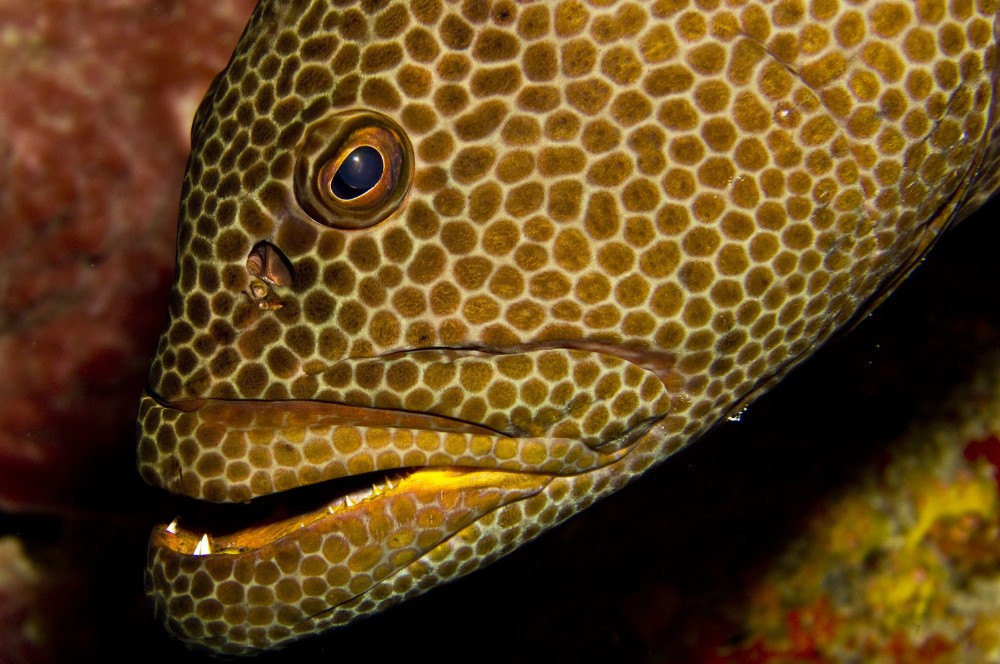
Yellowmouth Grouper
(Mycteroperca interstitialis)
The Yellowmouth Grouper, also known as the Crossband Rockfish or Hamlet, is a large species easily recognized by the yellow markings around its mouth. Its body features rusty brown stripes with occasional yellow accents and a white underbelly. With a lifespan of up to 45 years, it primarily inhabits rocky bottoms and coral beds at depths of around 80 feet, occasionally venturing into shallower waters while playing a key role in the marine ecosystem.
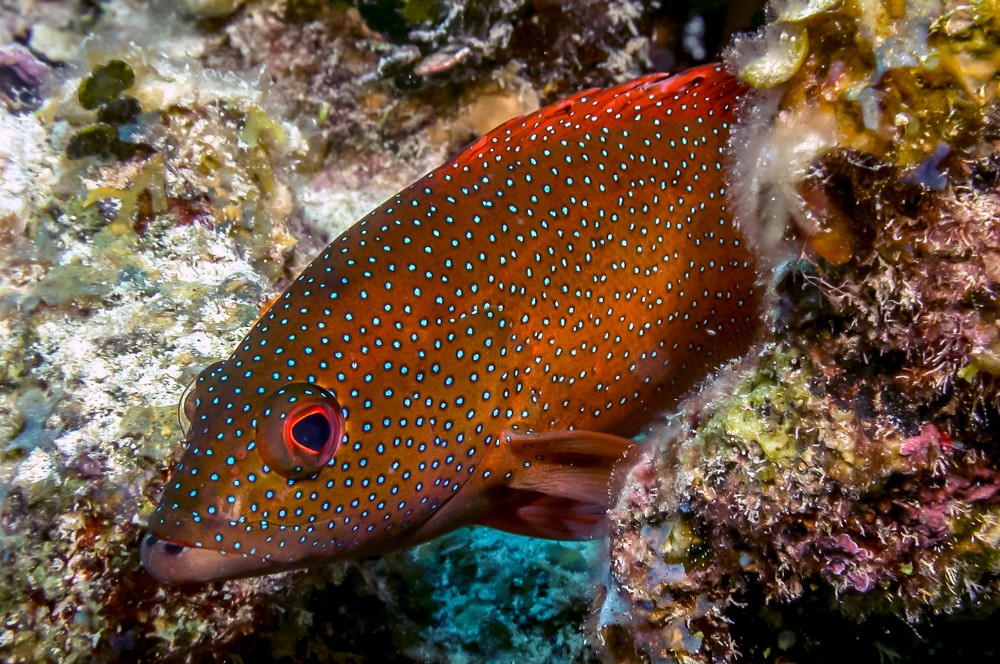
Coney
(Epinephelus fulvus)
The Coney Grouper comes in three distinct color variations: reddish-brown in deep waters, bicolored orange and light brown in shallow areas, and yellow across various depths, though the reddish-brown is most common. All share two dark spots on the body and black blotches on the lower jaw. Typically found in clear coral reefs, Coneys are territorial, especially males, and primarily feed on small fish and crustaceans. They can live up to 25 years.
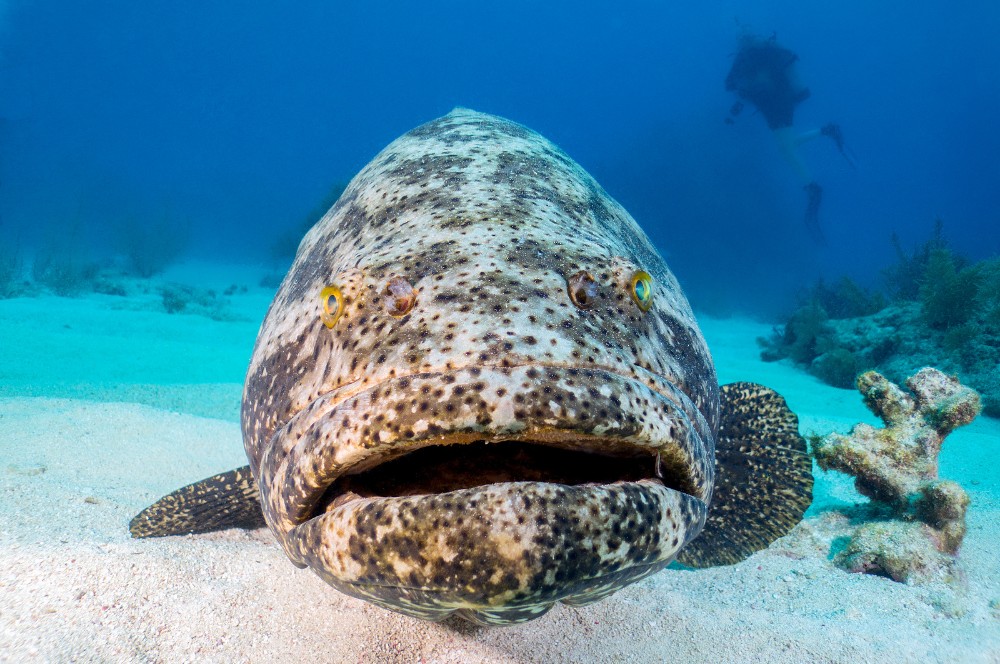
Goliath Grouper
(Epinephelus itajara)
The Goliath Grouper, the largest of its kind, is a solitary giant with a mottled yellow-brown to gray body marked by dark stripes and spots. When threatened, it displays aggressive body language and produces a deep rumbling sound. Found in rocky coral reefs and muddy inshore waters, this apex predator has a diverse diet, consuming crustaceans, fish, stingrays, young sea turtles, and even small sharks. With a lifespan of up to 50 years, the Goliath Grouper plays a vital role in maintaining marine ecosystem balance.
